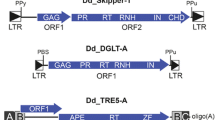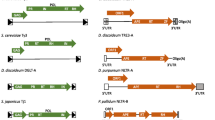Abstract
An Escherichia coli model system was developed to estimate the capacity of the integrase of the Drosophila melanogaster retrotransposon gypsy (mdg4) for precise excision of the long terminal repeat (LTR) and, hence, the entire gypsy. The gypsy retrotransposon was cloned in the form of a PCR fragment in the pBlue-Script II KS+ vector (pBSLTR), and the region of the second open reading frame (INT ORF2) of this element encoding integrase was cloned under the lacZ promoter in the pUC19 vector and then recloned in pACYC184 compatible with pBSLTR. The LTR was cloned in such a manner that its precise excision from the recombinant plasmid led to the restoration of the nucleotide sequence and the function of the lacZ gene; therefore, it was detected by the appearance of blue colonies on a medium containing X-gal upon IPTG induction. Upon IPTG induction of E. coli XL-1 Blue cells obtained by cotransformation with plasmids pACYCint and pBSLTR on an X-gal-containing medium, blue clones appeared with a frequency of 10−4 to 10−3, the frequency of spontaneously appearing blue colonies not exceeding 10−9 to 10−8. The presence of blue colonies indicated that that the integrase encoded by the INT ORF2 (pACYCint) fragment was active. After the expression of the integrase, it recognized and excised the gypsy LTR from pBSLTR, precisely restoring the nucleotide sequence and the function of the lacZ gene, which led to the expression of the β-galactosidase enzymatic activity. PCR analysis confirmed that the LTR was excised precisely. Thus, the resultant biplasmid model system allowed precise excisions of the gypsy LTR from the target site to be detected. Apparently, the gypsy integrase affected not only the LTR of this mobile element, but also the host genome nucleotide sequences. The system is likely to have detected only some of the events occurring in E. coli cells. Thus, the integrase of gypsy is actually capable of not only transposing this element by inserting DNA copies of the gypsy retrotransposon to chromosomes of Drosophila, but also excising them. gypsy is excised via a precise mechanism, with the original nucleotide sequence of the target site being completely restored. The obtained data demonstrate the existence of alternative ways of the transposition of retrotransposons and, possibly, retroviruses, including gypsy (mdg4).
Similar content being viewed by others
References
Ilyin, Y.V., Tchurikov, N.A., and Ananiev, E.V., Studies on the DNA Fragments of Mammals and Drosophila Containing Structural Genes Adjacent Sequences, Cold Harbor Symp. Quant. Biol., 1978, vol. 42, pp. 959–969.
Ilyin, Y.V., Lyubomirskaya, N.V., and Kim, A.I., Retrotransposon gypsy and Genetic Instability in Drosophila, Genetica (The Hague), 1991, vol. 85, no. 1, pp. 13–22.
Pelisson, A., Teysset, L., Chalvet, F., et al., About the Origin of Retroviruses and Co-Evolution of the gypsy Retrovirus with the Drosophila flamenco Host Gene, Genetica (The Hague), 1997, vol. 100, pp. 29–37.
Kim, A., Terzian, C., Santamaria, P., et al., Retroviruses in Invertebrates: The gypsy Retrotransposon Is Apparently an Infectious Retrovirus of Drosophila melanogaster, Proc. Natl. Acad. Sci. USA, 1994, vol. 91, no. 4, pp. 1285–1289.
Song, S.U., Kurkulos, M., Boeke, J.D., and Corces, V.G., Infection of the Germ Line by Retroviral Particles Produced in the Follicle Cells: A Possible Mechanism for the Mobilization of the gypsy Retroelement of Drosophila, Development, 1997, vol. 124, no. 14, pp. 2789–2798.
Desset, S., Conte, C., Dimitri, P., et al., Mobilization of Two Retroelements, ZAM and Idefix, in a Novel Unstable Line of Drosophila melanogaster, Mol. Biol. Evol., 1999, vol. 16, no. 1, pp. 54–66.
Coffin, J.M., Hughes, S.H., and Varmus, H.E., Retroviruses, New York: Cold Spring Harbor Laboratory, 1999.
Kim, A.I., Belyaeva, E.S., Larkina, Z.G., and Aslanyan, M.M., Genetic Instability and Transpositions of the MDG4 Mobile Element in a Mutator Strain of Drosophila melanogaster, Genetika (Moscow), 1989, vol. 25, no. 10, pp. 1747–1756.
Kim, A.I. and Belyaeva, E.S., Transpositions of MDG4 against the Background of a Constant Location of Other Mobile Elements in a Genetically Unstable Mutator Strain of Drosorhila melanogaster, Dokl. Akad. Nauk SSSR, 1986, vol. 289, no. 5, pp. 1248–1252.
Kuzin, A.B., Lyubomirskaya, N.V., Ilyin, Yu.V., et al., The Hot Spot of MDG4 Retransposon Insertion into Locus forked and Its Precise Excision, Dokl. Akad. Nauk, 1994, vol. 335, no. 5, pp. 656–658.
Kuzin, A.B., Lyubomirskaya, N.V., Khudaibergenova, B.M., et al., Precise Excision of the Retrotransposon gypsy from the forked and cut Loci in a Genetically Unstable D. melanogaster Strain, Nucl. Acids Res., 1994, vol. 22, no. 22, pp. 4641–4645.
Prudhomme, N., Gans, M., Masson, M., et al., Flamenco, a Gene Controlling the gypsy Retrovirus of Drosophila melanogaster, Genetics, 1995, vol. 139, no. 2, pp. 697–711.
Glukhov, I.L., Il’in, Yu.V., and Ivanov, V.A., The Specific Endonuclease Activity of the Retrotransposon MDG4 (gypsy) Integrase, Mol. Biol. (Moscow), 2000, vol. 34, no. 2, pp. 277–284.
Van Gent, D.C., Elgersma, Y., Bolk, M.W., et al., DNA Binding Properties of the Integrase Proteins of Human Immunodeficiency Viruses Types 1 and 2, Nucl. Acids Res., 1991, vol. 19, no. 14, pp. 3821–3827.
Sambrook, J., Fritsch, E.F., and Maniatis, T., Molecular Cloning: A Laboratory Manual, New York: Cold Spring Harbor Laboratory, 1989, 2nd ed.
Holmes, D.S. and Quigley, M., A Rapid Boiling Method for the Preparation of Bacterial Plasmids, Anal. Biochem., 1981, vol. 114, no. 1, pp. 193–197.
Hoover, K.K., Chien, A.J., and Corces, V.G., Effects of Transposable Elements on the Expression of the forked Gene of Drosophila melanogaster, Genetics, 1993, vol. 135, no. 2, pp. 507–526.
Johnson, M.S., McClure, M.A., Feng, D.F., et al., Computer Analysis of Retroviral pol Genes: Assignment of Enzymatic Functions to Specific Sequences and Homologies with Nonviral Enzymes, Proc. Natl. Acad. Sci. USA, 1986, vol. 83, no. 20, pp. 7648–7652.
Glukhov, I.L., Ilyin, Yu.V., and Ivanov, V.A., Cloning and Expression of the MDG4 (gypsy) Mobile Genetic Element Integrase Domain in E. coli, Dokl. Akad. Nauk, 1998, vol. 363, no. 1, pp. 114–117.
Ogura, K. and Yamamoto, M.T., Mariner-like Element with a 5′ Lesion in Drosophila simulans, Genetics, 2003, vol. 119, no. 3, pp. 229–235.
Ganguly, I., Mackay, T.F., and Anholt, R.R., Scribble Is Essential for Olfactory Behavior in Drosophila melanogaster, Genetics, 2003, vol. 164, no. 4, pp. 1447–1457.
Author information
Authors and Affiliations
Additional information
Original Russian Text © L.N. Nefedova, N.V. Ljubomirskaya, Yu.V. Ilyin, A.I. Kim, 2006, published in Genetika, 2006, Vol. 42, No. 12, pp. 1656–1663.
Rights and permissions
About this article
Cite this article
Nefedova, L.N., Ljubomirskaya, N.V., Ilyin, Y.V. et al. Precise excision of long terminal repeats of the gypsy (mdg4) retrotransposon of Drosophila melanogaster detected in Escherichia coli cells is explained by its integrase function. Russ J Genet 42, 1398–1404 (2006). https://doi.org/10.1134/S1022795406120064
Received:
Issue Date:
DOI: https://doi.org/10.1134/S1022795406120064




